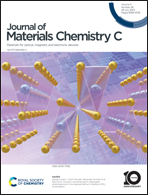Ternary alloyed MoS2–xSex nanocomposites with a carrier mobility-dominated gas sensing mode: a superior room temperature gas sensing material for NO2 sensors
Abstract
For most resistive sensors, the change of carrier concentration usually dominates the conductivity change in the gas sensing process, while the role of carrier mobility change is difficult to reflect. In this work, a ternary alloyed MoS2−xSex gas sensing material with high crystal quality and a carrier mobility-dominated gas-sensing (CMDGS) mode has been successfully prepared by a one-pot solvothermal method for the detection of NO2 gas. It is found that the alloyed MoS2−xSex nanocomposites with the best crystal quality have the lowest charge transfer resistance and baseline resistance, which can be attributed to the high carrier mobility and low carrier effective mass. The response of the best MoS2−xSex sensor to 50 ppm NO2 is as high as 92.8 at room temperature (25 °C) with a response and a recovery time of 25 and 22 s, respectively, which are about 42.0 times those of the MoS2 sensor. The actual and theoretical detection limits reach 10 ppb and 37.1 ppt, respectively. This study reveals that the CMDGS mode can be realized by improving the crystal quality and establishing the local built-in electric field of the sensing materials, which is more progressive than the carrier concentration-dominated gas sensing (CDDGS) mode.

- This article is part of the themed collection: #MyFirstJMCC


 Please wait while we load your content...
Please wait while we load your content...